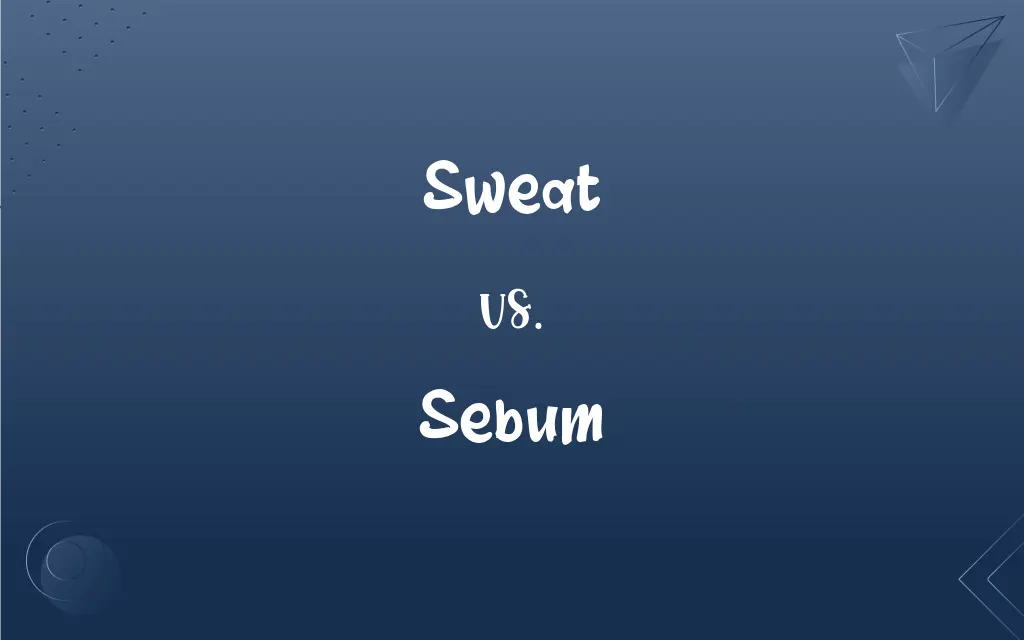Sweat vs. Sebum: What's the Difference?
Edited by Aimie Carlson || By Harlon Moss || Updated on October 18, 2023
Sweat is a salty fluid excreted by sweat glands, while sebum is an oily secretion from sebaceous glands.

Key Differences
Sweat and sebum are both naturally produced by the human body, but they serve different purposes. Sweat is a transparent, salty fluid produced by sweat glands, primarily as a means of regulating body temperature. When the body heats up, sweat is produced to help cool it down as the liquid evaporates from the skin. Sebum, on the other hand, is a light yellow, oily substance secreted by the sebaceous glands located close to hair follicles. It acts to lubricate and waterproof the hair and skin.
Sweat consists mainly of water, with small amounts of minerals, lactic acid, and urea. It is the body's mechanism to remove excess heat and some waste products, and it plays a key role in maintaining homeostasis. Sebum, in contrast, contains fats, waxes, and other cellular debris. Its primary role is to maintain the integrity of the skin and hair by preventing them from drying out, and it also possesses antimicrobial properties that protect the skin from harmful microorganisms.
While both sweat and sebum are essential for skin health, an imbalance in their production can lead to skin issues. Excessive sweating, known as hyperhidrosis, can lead to discomfort, skin irritation, and social embarrassment. Overproduction or underproduction of sebum, on the other hand, can lead to various skin conditions. Too much sebum can result in oily skin and acne, while too little can cause dry and flaky skin.
Sweat, being water-based, doesn't have a strong odor of its own. However, when it mixes with bacteria on the skin, it can produce body odor. Sebum is odorless but plays a crucial role in the overall health and texture of the skin. The overproduction of sebum is often linked to hormonal changes, and it can lead to blocked pores and the formation of pimples.
Comparison Chart
Composition
Mainly water with minerals, lactic acid, and urea.
Contains fats, waxes, and cellular debris.
ADVERTISEMENT
Function
Regulates body temperature by cooling the skin.
Lubricates and protects hair and skin.
Origin
Produced by sweat glands.
Secreted by sebaceous glands near hair follicles.
Associated Conditions
Hyperhidrosis (excessive sweating) can lead to skin irritation.
Overproduction can result in oily skin and acne; underproduction can cause dry skin.
Interaction with Bacteria
Can produce body odor when mixed with bacteria.
Has antimicrobial properties that protect against harmful microorganisms.
Sweat and Sebum Definitions
Sweat
Physical or mental exertion causing perspiration.
She broke into a sweat trying to solve the puzzle.
ADVERTISEMENT
Sebum
A protective lubricant for hair and skin.
Sebum keeps the skin moisturized and healthy.
Sweat
A state of anxiety or nervousness.
The upcoming interview had him in a sweat.
Sebum
An oily substance secreted by sebaceous glands.
Overproduction of sebum can lead to acne.
Sweat
To work hard or exert oneself.
She sweated for hours to perfect the dance routine.
Sebum
Plays a role in waterproofing the skin.
Sebum acts as a barrier against external elements.
Sweat
A fluid produced by the body to regulate temperature.
He wiped the sweat off his brow after the run.
Sebum
Has antimicrobial properties.
Sebum protects the skin from certain bacteria and fungi.
Sweat
To produce a liquid from the body's sweat glands.
It's so hot outside; I'm starting to sweat.
Sebum
Composed of fats, waxes, and other components.
A change in sebum composition can affect skin health.
Sweat
To excrete perspiration through the pores in the skin; perspire.
Sebum
The semifluid secretion of the sebaceous glands, consisting chiefly of fat, keratin, and cellular material.
Sweat
To exude in droplets, as moisture from certain cheeses or sap from a tree.
Sebum
(physiology) A thick oily substance, secreted by the sebaceous glands of the skin, that consists of fat, keratin and cellular debris.
Sebum
The oily secretion of the sebaceous glands; with perspiration it moistens and protects the skin
FAQs
What factors can influence sebum production?
Hormonal changes, diet, and genetics can influence sebum production.
Can excessive sweating be a medical condition?
Yes, excessive sweating is known as hyperhidrosis, which can be a medical condition.
Where is sebum produced in the body?
Sebum is produced by the sebaceous glands, often located near hair follicles.
Does sweat have an odor?
Sweat itself is mostly odorless, but when mixed with skin bacteria, it can produce body odor.
What's the main difference between sweat and sebum?
Sweat is a water-based fluid for cooling, while sebum is an oily secretion for skin and hair lubrication.
Is sweat just water?
No, sweat also contains small amounts of minerals, lactic acid, and urea.
Can you alter the composition of sebum?
Yes, factors like diet, medications, and overall health can affect sebum composition.
How can one reduce excessive sweating?
Antiperspirants, medications, and certain medical procedures can help reduce excessive sweating.
How can one control excessive sebum production?
Skincare routines, dietary changes, and certain medications can help regulate sebum production.
Why does sweat sometimes stain clothing?
Sweat can react with deodorants, body products, or fabric, leading to yellowish stains.
Can physical activity influence sweat production?
Yes, physical activity can increase body temperature, leading to increased sweat production.
What role does sebum play in acne formation?
Overproduction of sebum can lead to clogged pores, resulting in acne.
Can a lack of sebum result in skin problems?
Yes, an underproduction of sebum can lead to dry and flaky skin.
Is sebum only present on the scalp?
No, sebum is found all over the body, wherever there are sebaceous glands, but is most notable on the face and scalp.
What is the primary role of sweat?
Sweat primarily helps regulate body temperature by cooling the skin.
Are there different types of sweat glands?
Yes, the body has both eccrine and apocrine sweat glands, serving different functions.
Can sebum production change over one's lifetime?
Yes, sebum production often decreases with age.
Is sebum harmful to the skin?
No, sebum is beneficial for skin health but can cause issues if produced in excess.
Does everyone produce the same amount of sebum?
No, sebum production varies among individuals and can be influenced by factors like age, gender, and hormones.
Is sweat always a result of heat?
No, sweat can also be caused by stress, anxiety, certain foods, or medical conditions.
About Author
Written by
Harlon MossHarlon is a seasoned quality moderator and accomplished content writer for Difference Wiki. An alumnus of the prestigious University of California, he earned his degree in Computer Science. Leveraging his academic background, Harlon brings a meticulous and informed perspective to his work, ensuring content accuracy and excellence.
Edited by
Aimie CarlsonAimie Carlson, holding a master's degree in English literature, is a fervent English language enthusiast. She lends her writing talents to Difference Wiki, a prominent website that specializes in comparisons, offering readers insightful analyses that both captivate and inform.































































